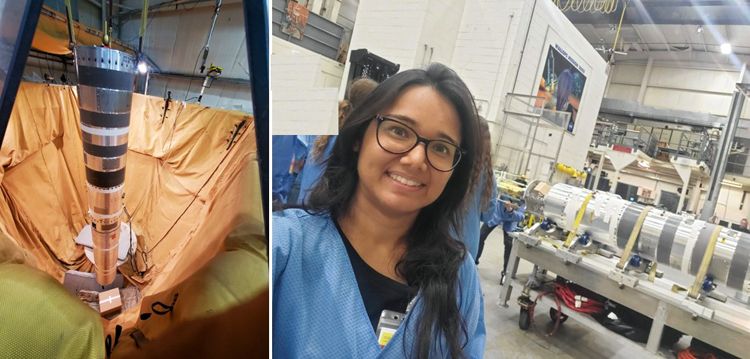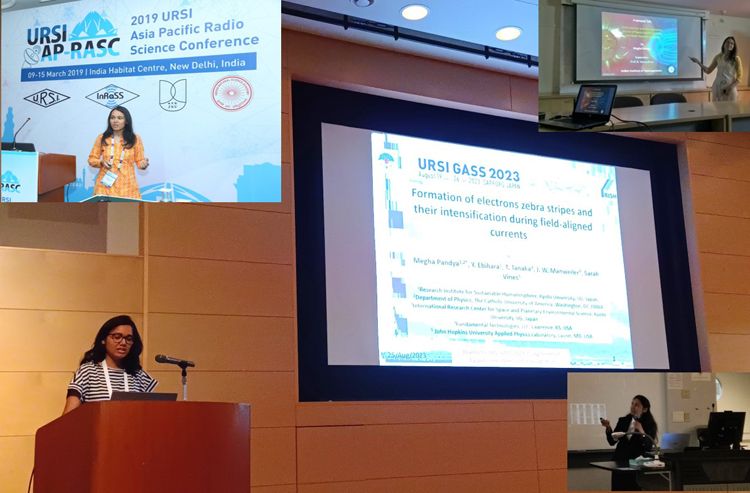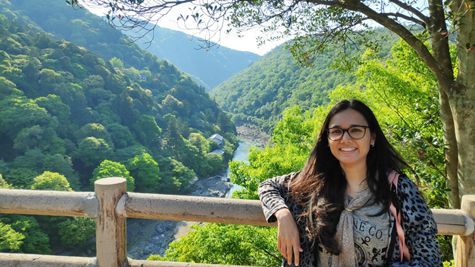Early Career Scientist Spotlight
Dr. Megha Pandya (she/her/hers)
Space Physicist
Geospace Physics Laboratory (673)
What motivated you to pursue a career in space physics?
From my early days, I’ve always been a “curious kiddo”, teaming up with my elder sibling in our grand adventures of dissecting broken small electronic toys in an attempt to mend them and, occasionally, restore them to functionality. These early days of understanding the physical world around me blossomed further during middle school, where hands-on physics experiments became a source of joy. Coincidentally, at that time, I discovered a weekly recurring event called 'Sunday Science', organized by our city’s community science center. It was like Hogwarts but with fewer owls and more laboratory experiments and astronomical field trips. Suddenly, the world of planets, the Sun, gravity, magnetism, and the ever-mystifying plasma came alive outside of the dull classroom.
Fast forward to my undergraduate escapades, where I found myself conducting a hands-on experimental project on calibrating the quadruple mass spectrometer used for analyzing the residual gases and laboratory plasma diagnostics at the Institute of Plasma Research, India. While the controlled environment of lab plasma is undeniably intriguing, I was totally mesmerized to imagine how fascinating the naturally occurring plasma in space could be. This began my journey in exploring space plasma. Nature guided me toward realizing my aspirations and allowing me to achieve what I had always envisioned.

Credit: Dr. (Er.) Robertson and Ms. Mirizio
Tell us about the research projects you are currently working on.
High-energy charged particles, often in the keV energy range, become trapped in the magnetosphere, subject to various forces that drive their transport, acceleration, or loss. When these charged particles approach the Earth's surface, reaching as close as 100 km, they initiate a mesmerizing display known as an aurora. Apart from simply being pretty colors, these auroras are like secret messages that can help decipher the physical processes occurring in the Earth’s magnetosphere.
As charged particles, primarily electrons, collide with the gases in the Earth's upper atmosphere, they transfer energy to the atoms and molecules in the gas. When these excited particles return to their original state, they release this energy in the form of light, creating the vibrant hues characteristic of auroras. I work like a space detective, utilizing special cameras on the ground to study and understand these beautiful lights. Each color corresponds to a specific gas in the atmosphere, providing clues about the composition of the upper atmosphere. These mesmerizing lights not only offer a celestial spectacle, but also serve as encrypted messages conveying information about the mechanisms acting on the charged particles.
Moreover, understanding auroral processes is important due to the potential impact of charged particles on delicate technologies. These particles can interfere with satellite communications, disrupt power grids, and pose risks to navigation systems. By unraveling the secrets hidden in the auroras, scientists aim to improve space weather predictions, ultimately mitigating the potential effects on our technological infrastructure.
What does a typical day at work look like for you?
A typical day at work for me reflects the interesting evolution of my life as a researcher, deeply influenced by the unique places I've called home. If I were situated elsewhere, my daily routine would undoubtedly look different. As a researcher, I synchronize my efforts with the state of my mind and the creative spark of ideas, embracing a flexibility that goes beyond the constraints of the clock. There are moments when I find myself immersed in coding, unable to abruptly halt and conclude my workday. I dedicate substantial time to tasks that inspire my curiosity and endeavor to bring them to fulfillment in alignment with my vision, irrespective of the working hours.
This flexibility with time traces back to my graduate school days when collaborating with scientists across the world habituated in me the necessity for swift responses to emails and adaptability in scheduling for online meetings. After receiving my Ph.D., I was honored with the incredible opportunity to relish family moments and immerse myself in the distinctive work culture at Kyoto University, gaining insights into Japanese research practices and the beauty of cultural diversity.
Another significant shift occurred as I made a direct transition from Japan to the USA. Here, each day presents itself as another extraordinary opportunity, navigating diverse experiences while striving to strike a harmonious balance between work and life. My daily routine is built from a collection of influences from the unique places I've called home, not just in my work but in the fundamental ways I approach life as a researcher.

Credit: Dr. Pandya
What is one of your favorite moments in your career so far?
Reflecting on my life, I cherish not just one but two extraordinary moments. The first is meeting my first post-doc mentor, Prof. Ebihara, for the first time in the year 2021. It was a truly amazing to meet him at Rokujizo, Kyoto, where I finally happen to see the guiding ‘secret angel’ of my academic journey. I call him my 'secret' angel because, despite five years of mentorship, I never had the chance to meet him virtually or in person until I joined Kyoto University as his postdoc. His influence not only shaped my academic path but also granted me the incredible opportunity to immerse myself in rich Japanese culture, leaving me with invaluable life lessons. His dedication to science is truly inspiring, motivating me to pursue meaningful research.
The second pivotal moment is returning to NASA Goddard Space Flight Center (GSFC) as a postdoctoral researcher with another wonderful scientist Dr. Samara. In 2019, I was a summer intern at GSFC, an experience that profoundly impacted my scientific aspirations. Little did I know that an exciting chapter awaited me. Coming back to familiar surroundings, coupled with the prospect of delving into auroral research with Dr. Samara and her team, feels like a full-circle journey. It's not just a continuation; it's an elevation to a more significant role, presenting an opportunity to contribute meaningfully to ongoing scientific projects. As I embark on this new phase of my research career, I carry the lessons of the past, gratitude for the present, and heightened enthusiasm for the increased scientific understanding that lies ahead.
What skills are most useful to you in your work, and where did you develop those skills?
In my opinion, the most important skill is using computer codes to understand data. The real magic is in learning how to use tools to explore the information hidden in our data. When I was in grad school, it was like being part of a group of researchers on a magical adventure. We weren't just coworkers; we were friends exploring different areas like geophysics, earth science, and theory; always dragging each other into our research tasks, where solving problems and creating codes were our daily challenges. Together we improved our computer skills like playful little creatures trying out different coding languages. Sometimes, we didn't just create codes for ourselves but also helped each other, like wizards sharing magical spells. This teamwork not only made us better at coding but also filled our academic world with laughter.

Credit: Dr. Pachigolla, Dr. Barik, Ms. Saini, Er. Garcia Morilla
What aspect of your work excites you the most?
The sheer joy lies in the realization that, despite working from a specific corner of the world, we can effortlessly have interactions with scientists from diverse backgrounds around the globe. The ability to meet and engage with fellow researchers, exchanging insights and ideas, adds a dynamic layer to our scientific career. It's more than just academic discourse; it's a celebration of shared knowledge and intellectual ideas where the boundaries between nations dissolve. Taking breaks to explore new environments, savor diverse cuisines, and immerse ourselves in new languages is an integral part of this journey. As we traverse the world, we carry science in our heads like an ever-present companion. It's an exciting ability to completely blend our academic passion with the pleasures of discovering new cultures and enjoying the richness of global diversity.
What do you like to do in your free time?
I really enjoy exploring different places and being close to nature, especially through hiking. It's like taking a break from the everyday life. Apart from my outdoor adventures, I love spending time in the kitchen. Cooking is not just a task; it's my way of being creative. Trying out new ingredients, mixing spices, and making delicious dishes is like going on a culinary adventure. On a different note, I'm also curious about languages. Learning new languages is not just an intellectual challenge; it helps me understand diverse cultures. It's like opening doors to connect with people from around us. All these things together make each day a colorful and exciting adventure for me.
Biography
Home Town:
Rajkot, Gujarat, India
Undergraduate Degree:
B.Sc, Physics, Saurashtra University, Gujarat, India
Post-graduate Degrees:
M.Sc Physics, Saurashtra University, Gujarat, India
Ph.D Department of Physics, University of Mumbai and Indian Institute of Geomagnetism, Mumbai, India

